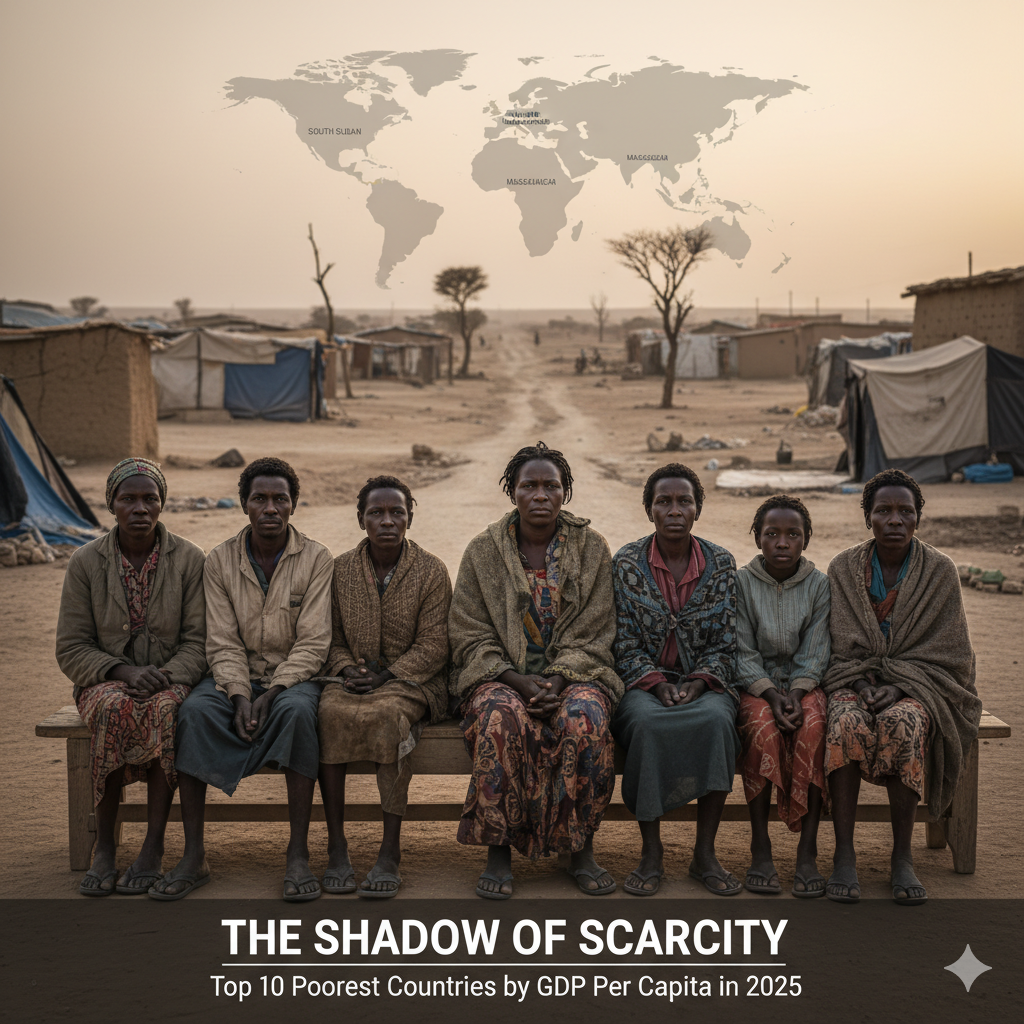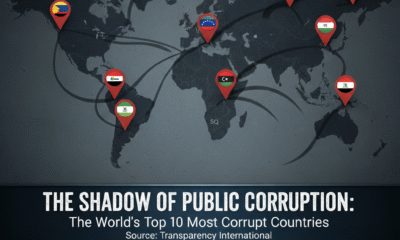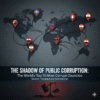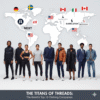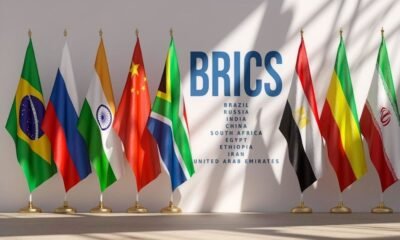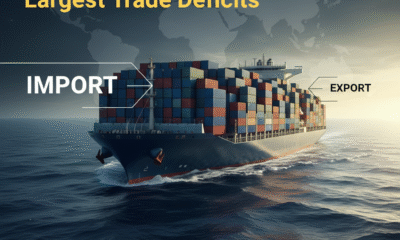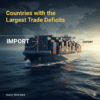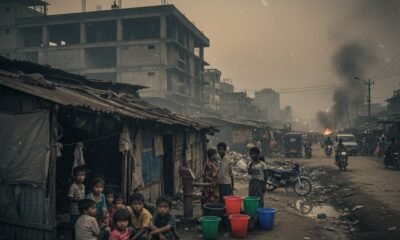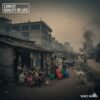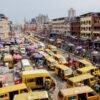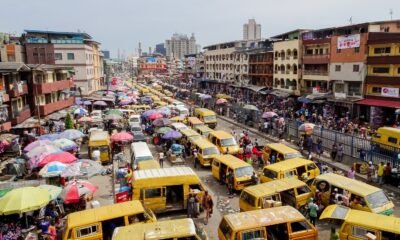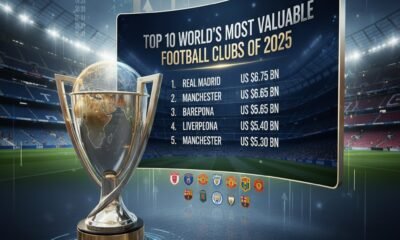Economy
Top 10 Poorest Countries by GDP Per Capita in 2025
According to the International Monetary Fund (IMF) data for 2025, several countries continue to struggle with very low levels of income per person.
These nations face economic challenges caused by conflict, weak governance, poor infrastructure, and limited industrial development.
Many of these countries are in Africa, where war, corruption, and political instability have slowed growth for decades and despite efforts by local governments and international organisations to improve the situation, progress has remained slow.
Moreover, economic shocks, climate change, and dependence on agriculture have made it hard for these nations to achieve stable growth.
This article look closely at the ten poorest countries in the world, based on their projected GDP per capita for the year 2025. The figures used in this analysis come directly from the IMF projections and countries only with the projected GDP per capita of less than $1,000 are considered.
South Sudan: $251
South Sudan holds the unfortunate spot as the poorest country on this list, with a projected GDP per capita of only $251. This young nation has struggled with conflict since its birth, which severely limits its ability to grow and develop.
South Sudan gained independence from Sudan in 2011. This followed decades of civil war, one of Africa’s longest armed struggles. The people voted overwhelmingly for secession, hoping for peace and self-rule. However, soon after independence, a new internal conflict erupted between rival political factions.
The continuous civil war has ruined the country’s oil-dependent economy and infrastructure. The political elite has often been accused of misusing the nation’s wealth, a system observers call a “violent kleptocracy.” The ongoing violence has caused massive displacement, a humanitarian crisis, and a famine considered to be man-made by war.
Yemen: $417
The nation of Yemen is second on this list, with a projected GDP per capita of $417. Years of devastating war and political crisis have completely shattered its economy and social fabric.
Yemen’s history is ancient, with early civilizations like the Sabaeans building wealth through the spice trade and impressive infrastructure, such as the Ma’rib Dam. The country later became a unified republic in 1990. Before then, it was split into North Yemen and South Yemen for much of the 20th century, following Ottoman and British rule in the respective regions.
Today, Yemen is caught in a long, brutal civil war that began in 2014. This war is an international conflict that has created the world’s worst humanitarian catastrophe. The conflict has destroyed roads, hospitals, and power grids. Trade routes are blocked, and economic activity is almost at a standstill.
Burundi: $490
Burundi is third with a projected GDP per capita of $490. This small, landlocked country in the African Great Lakes region struggles with ethnic tension, overpopulation, and a severe lack of resources.
The country originated as a 16th-century kingdom, which was later incorporated into the German and then Belgian colony of Ruanda-Urundi. Unlike many African nations, its borders reflect its pre-colonial state. Post-independence in 1962, Burundi immediately faced political turmoil and repeated outbreaks of ethnic conflict between the Hutu majority and the Tutsi minority.
Political instability and violence have marked Burundi’s development for decades. It remains heavily dependent on subsistence agriculture, but the land is often overworked and degraded. The constant crises have prevented consistent foreign investment. Today, poverty is extreme, and food security is a major concern for most of its citizens.
Central African Republic (CAR): $532
The Central African Republic has a projected GDP per capita of $532. This country is rich in resources like diamonds, gold, and timber but is kept poor by continuous violence and a fragile government.
The CAR was colonized by the French and gained independence in 1960. Since then, its history has been plagued by a series of coups and military rule. A major crisis began with the seizure of power in 2013, which sparked an ongoing civil conflict.
Despite having vast natural wealth, the CAR has one of the world’s lowest human development rankings. Armed groups control large parts of the territory, which makes governance impossible. The violence forces people to flee their homes and makes agriculture difficult. Chronic electricity shortages and poor infrastructure also prevent any meaningful economic growth.
Malawi: $580
Malawi is fifth on the list, with a projected GDP per capita of $580. This country faces significant challenges due to its heavy reliance on rain-fed agriculture and its vulnerability to severe weather events.
Malawi was once the British colony of Nyasaland. It became independent in 1964 and was led by a single-party government for many years. A multiparty democracy was established in 1994.
The Malawian economy is primarily based on agriculture. Most of its people are subsistence farmers who rely on crops like maize. It is a landlocked nation, which increases the cost of imports and exports. The country experiences frequent droughts and floods, which destroy harvests and cause widespread food shortages. This constant vulnerability keeps the nation locked in a cycle of poverty.
Madagascar: $595
The island nation of Madagascar has a projected GDP per capita of $595. It is known worldwide for its unique wildlife, but the nation itself struggles with weak governance and severe environmental challenges.
Waves of settlers, mainly from Austronesian and Bantu backgrounds, first populated Madagascar. For centuries, various kingdoms rose to prominence. The French formalized their colonization in 1896, which was followed by a period of resistance and a widespread revolt in 1947. Madagascar gained independence in 1960.
Development since independence has been slow, often derailed by political crises and coups. The majority of the population works in low-value agriculture, often struggling to feed their families. The country has a fragile environment. Massive deforestation leads to soil erosion, which makes farming harder. The nation is also highly vulnerable to tropical cyclones, which cause great economic damage.
Sudan: $625
Sudan is seventh on this list, with a projected GDP per capita of $625. This nation has seen its economy repeatedly crushed by decades of conflict and political instability, including the loss of its south.
Sudan’s modern history began with its independence in 1956. For decades, it suffered from two of the longest civil wars on the African continent. The secession of South Sudan in 2011 led to a massive economic shock because Sudan lost most of its oil revenue.
Sudan has recently experienced a major escalation in conflict, which began in 2023. This internal war has shattered its capital, Khartoum, and disrupted all major economic activities. The conflict has caused the largest displacement crisis in the world and put millions on the brink of acute hunger. The fighting makes recovery efforts nearly impossible.
Mozambique: $663
Mozambique has a projected GDP per capita of $663. This coastal southern African nation is struggling to recover from years of internal conflict and faces ongoing challenges from armed insurgency.
The Portuguese first arrived in the 16th century, though complex communities based on trade and agriculture had flourished long before. Mozambique was a Portuguese colony until 1975. A long and devastating civil war followed independence, lasting until 1992.
Despite having vast natural gas reserves and a beautiful coastline for tourism, political instability and conflict hurt development. The country also deals with a violent insurgency in its northern region. This prevents the large-scale exploitation of its gas wealth. Furthermore, Mozambique is often hit by devastating tropical cyclones, which cause huge damage to infrastructure and livelihoods.
Democratic Republic of the Congo (DRC): $743
The Democratic Republic of the Congo (DRC) has a projected GDP per capita of $743. It is a nation of immense mineral wealth, yet it is consistently ranked among the world’s poorest countries.
The DRC was once the personal property of Belgian King Leopold II. This period of colonial rule was marked by reckless exploitation and horrific abuses. After a chaotic independence in 1960, the country went through long periods of dictatorship and civil war, often called “Africa’s World War.” Millions died due to the conflict and its effects.
The country’s biggest problem is the control of its resources. Rich deposits of minerals like cobalt and copper often fuel conflict between rival armed groups. Government institutions are weak, and corruption is widespread. The ongoing violence, especially in the eastern provinces, prevents the establishment of a stable economy and the development of basic services for its people.
Niger: $751
Rounding out the top ten is Niger, with a projected GDP per capita of $751. This landlocked West African nation struggles with a hostile desert environment and repeated political coups.
Niger was a crossroads for ancient trans-Saharan trade routes and was later controlled by various empires. It became a French colony in 1922 and achieved independence in 1960. Since then, the country has experienced political instability, including a cycle of military and civilian rule.
The vast majority of Niger’s land is desert, making farming incredibly difficult. The population depends heavily on subsistence agriculture and cattle herding, which are often affected by drought. Political uncertainty, most recently a military coup in 2023, has led to cuts in international aid and has scared away foreign investment. The nation also faces severe security issues from insurgencies in the region.

